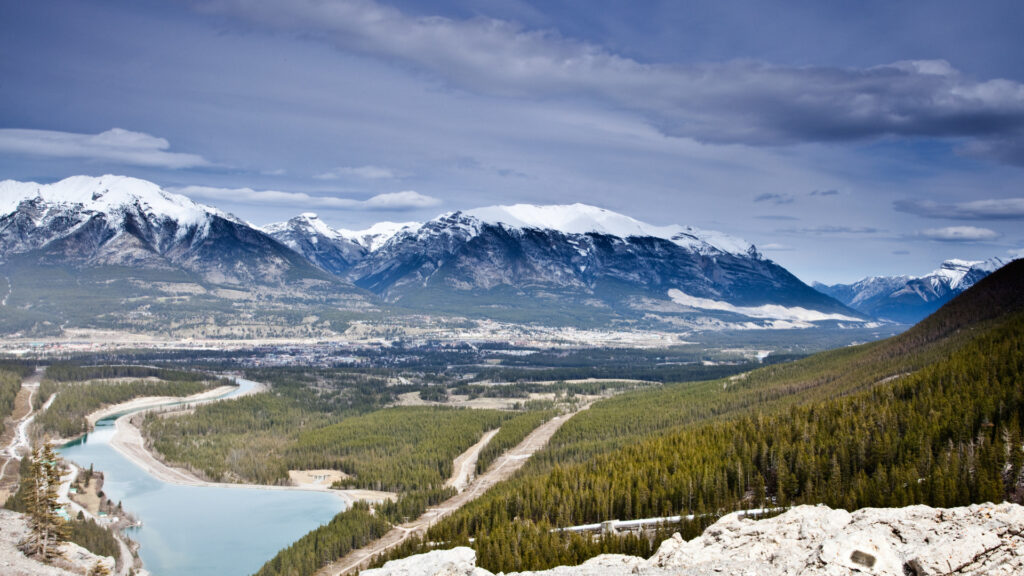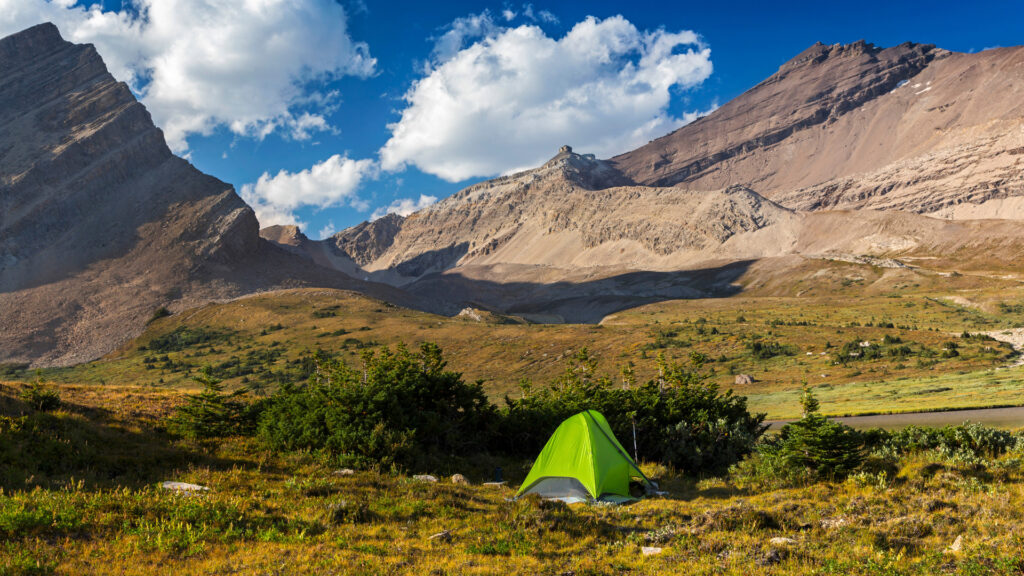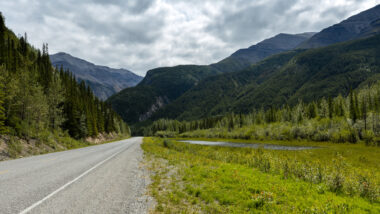Table of Contents Show
Did you know Canada has 37 national parks and 10 national park reserves?
The United States isn’t the only country with beautiful protected lands. Canada’s first national park, Banff National Park, is located just a few hours north of the Montana border and offers amazing camping opportunities.
It’s a popular summer vacation spot for Canadians and Americans. Let’s look at Banff camping options so you can start planning your adventure to our northern neighbor. Let’s dive in!
Where Is Banff National Park?
Banff National Park is located in Alberta, less than an hour from the British Columbia border.
It’s a little over an hour northwest of Calgary and about 3 and a half hours from the United States border in Montana. The Trans-Canada Highway leads to the national park, which makes it easily accessible.

Can You Camp in Banff National Park?
Banff camping is one of the best ways to experience the national park. It has 17 campgrounds with either reservable or first-come, first-served campsites.
You must camp in these designated locations. There is no free camping in Banff National Park like on Bureau of Land Management land in the United States.
Tunnel Mountain Village II is the only campground open year-round. Castle Mountain is closed until further notice. Protection Mountain, Mosquito Creek, and Waterfowl Lakes are all first-come, first-served campgrounds.
Most campgrounds are unserviced, with only amenities like fire pits, picnic shelters, and flush toilets. However, Tunnel Mountain Village II and Lake Louise Hard-Sided Campground offer electric hookups. Tunnel Mountain Trailer Court is the only option with full hookups.
About Bow Valley Campgrounds
Bow Valley is one location for Banff camping. This area includes the town of Banff, Lake Louise, and all of the campgrounds in between. You’ll find four Tunnel Mountain campgrounds near Banff.
One is an oTENTik campground, which is a cross between an A-frame cabin and a tent mounted on a raised wooden floor.
Tunnel Mountain Village I has over 600 campsites open from May to October. Tunnel Mountain Village II can accommodate RVs over 40 feet and offers electrical hookups. And Tunnel Mountain Trailer Court has over 300 full-hookup sites.
Two Jack Main Campground can accommodate RVs up to 24 feet. It has 380 campsites and provides drinking water, flush toilets, picnic shelters, fire pits, and a dump station. It’s a bit more secluded, about 6 miles from Banff. Two Jack Lakeside Campground is smaller, with only 74 campsites situated around Two Jack Lake.
Lake Louise has two campgrounds, one for soft-sided campers and tents and one for hard-sided RVs. They remain separated because of the bear activity in the area.
An electric fence surrounds the soft-sided campground. Each one has about 200 campsites, and the hard-sided campground offers electricity hookups.
Johnson Canyon Campground is another option for Banff camping in Bow Valley. It offers easy access to the popular Johnson Canyon Trail. These 132 primitive campsites can accommodate RVs up to 27 feet. Guests can enjoy drinking water, flush toilets, showers, picnic shelters, fire pits, and a dump station.
Finally, Protection Mountain, about 9 miles from Lake Louise, offers beautiful views of Protection and Castle Mountains. RVs up to 35 feet can fit here; however, you must use the dump station at the Lake Louise hard-sided campground. You get drinking water, flush toilets, picnic shelters, and fire pits on-site here.

About Icefields Parkway Campgrounds
North of Lake Louise along the Icefields Parkway, you’ll find four campgrounds: Mosquito Creek, Waterfowl Lakes, Rampart Creek, and Silverhorn Creek. None of these campgrounds have cell service, so keep that in mind.
Mosquito Creek has 38 campsites that can fit RVs up to 35 feet. It has no hookups, but guests can access drinking water, outhouses, picnic shelters, fire pits, and food storage lockers.
Waterfowl Lakes Campground sits between Upper and Lower Waterfowl Lakes. For paddlers, this is an ideal location for Banff camping. It has 110 campsites with the same on-site amenities as Mosquito Creek in addition to a dump station.
Situated along the banks of the North Saskatchewan River, Rampart Creek has 51 sites and can accommodate RVs up to 35 feet, but some loops can’t fit rigs over 25 feet. Campers must fill up with water and use the dump station at Waterfowl Lakes Campground.
Silverhorn Creek Campground is the fourth campground along the Icefields Parkway. These 45 sites can fit large RVs, but you’ll need to fill up with water and use the dump station at Waterfowl Lake Campground, too. Guests only have access to outhouses, picnic shelters, fire pits, and food storage lockers.
Keep in Mind: Are you planning a trip to Banff in the summer? Then check out list of Favorite Things To Do In Banff!
Do I Need a Permit for Banff Camping?
Campers must have a valid national park camping permit and a national park entry pass. You can purchase the camping permit online, over the phone (1-877-RESERVE), or at the campground kiosk.
You can also buy a national park entry pass online or at park gates, Parks Canada visitor centers, or staffed campground kiosks.
Do I Have to Make Reservations for Banff Camping?
As mentioned earlier, Banff National Park has some first-come, first-served campsites. These are located at Protection Mountain, Mosquito Creek, and Waterfowl Lakes.
All other campgrounds require reservations. It’s also important to remember that none of these campgrounds remain open year-round except Tunnel Mountain Village II, so plan accordingly.
Keep in Mind: Banff isn’t the only national park in Canada! Is Jasper National Park Worth Visiting? Let’s dive in!
Is There Free Banff Camping?
In the United States, we have free camping on public lands. For example, you can find dispersed camping on BLM lands or public trust lands.
However, Canada doesn’t offer this type of free camping. You must make a reservation or pay for a campsite upon arrival at one of the first-come, first-served locations.

Is Camping in Banff National Park Worth It?
Banff National Park is one of the treasured jewels of Canada. Banff camping is a great way to immerse yourself in the beauty of this area of Alberta.
The turquoise-blue glacial lakes and towering mountain peaks will take your breath away. Plus, all of the outdoor recreation, from hiking and mountain biking to paddling, offers endless hours of fun.
So is Banff camping worth it? Absolutely! But you must plan ahead as it’s a popular summer vacation spot. You can learn more about things to do in Banff National Park in our article “Our Favorite Things to Do in Banff in Summer.”
Where will you camp in Banff National Park?






